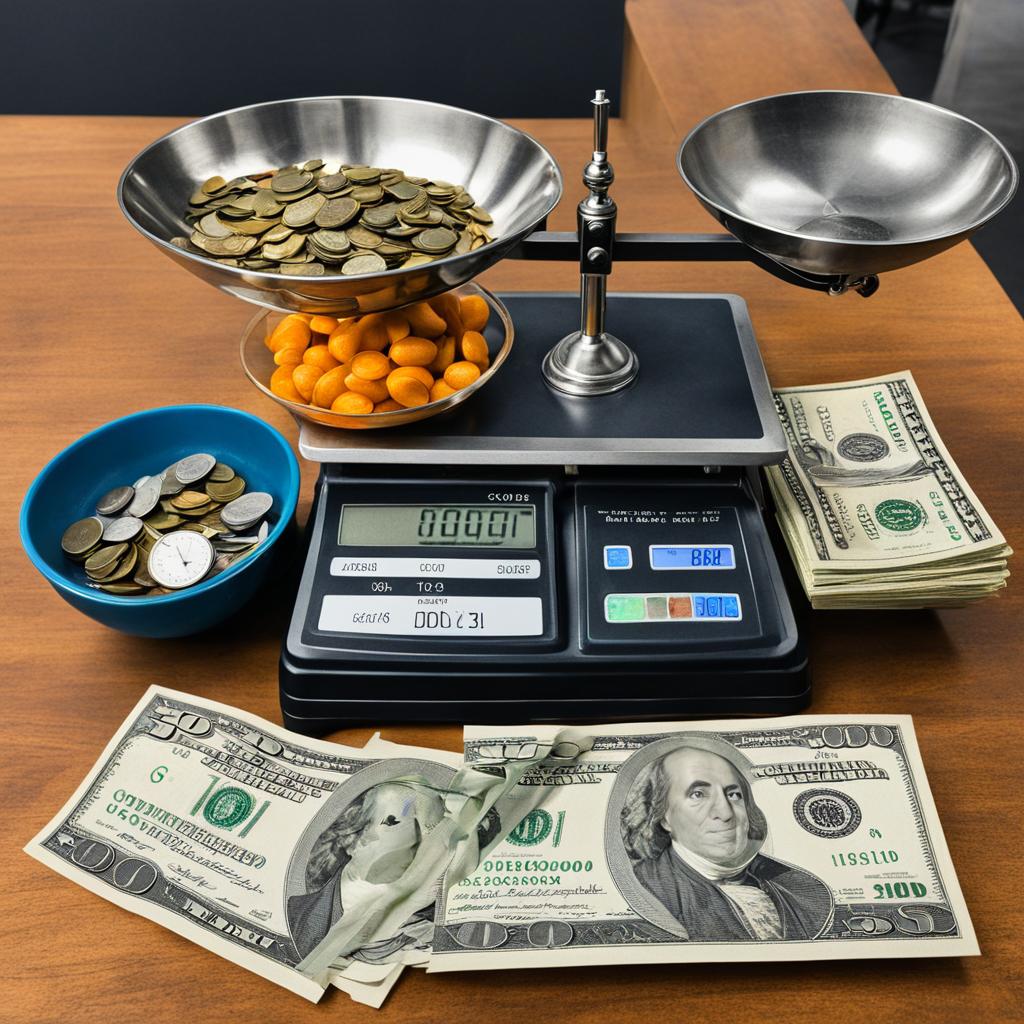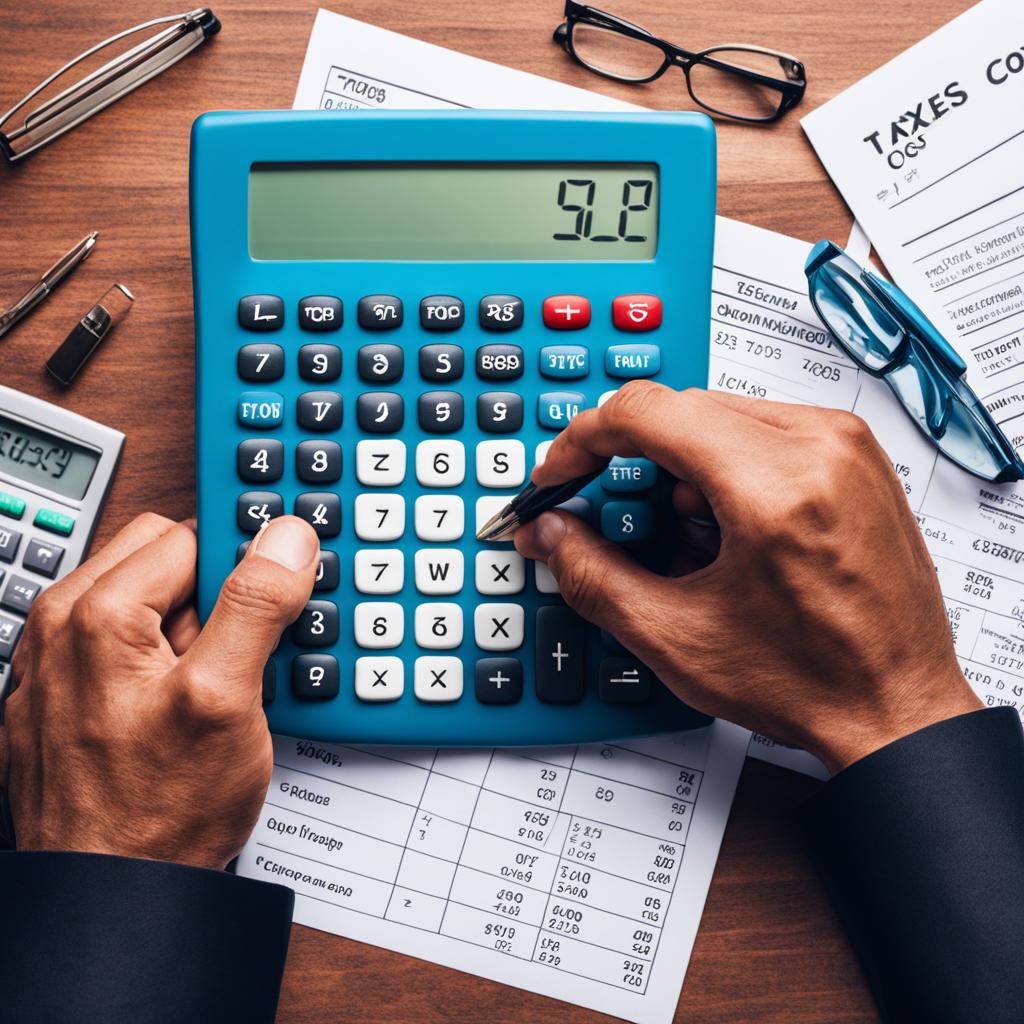In this article, I will provide a comprehensive guide on how to calculate the true cost of anything. Understanding the true cost of a product or service is essential for making cost-effective decisions. We will explore various methods and calculations that can help you determine the true cost of anything, whether it’s a cup of coffee or a larger purchase like a home. By the end of this article, you will have the tools to make informed and budget-conscious choices.
Key Takeaways:
- Calculating the true cost of a purchase allows for informed and budget-conscious decisions.
- Factors such as before-tax income price, life/time price, convenience cost, annual cost, and the future value of money should be considered.
- Understanding the true cost empowers individuals and businesses to make value-driven choices and ensure they are getting the best value for their money.
- By following the methods and calculations outlined in this article, you can navigate the world of pricing with confidence.
- Calculating the true cost uncovers hidden fees and promotes pricing transparency.
The Importance of Calculating True Cost
Calculating the true cost of a purchase is crucial for effective budgeting and finding cost-effective solutions. When making financial decisions, it’s important to consider all factors that contribute to the overall cost. By understanding the true cost, you can make informed choices and ensure that you are getting the best value for your money.
There are several key factors to consider when calculating the true cost:
- Before-tax income price: By factoring in your tax bracket and other tax-related expenses, you can determine how much you need to earn before taxes to afford a particular item.
- Life/time price: This involves evaluating how much of your time or “life energy” you are trading for a specific purchase. Understanding the value of your time can help you make conscious decisions about your purchases.
- Price of convenience: Convenience often comes at a higher cost. By comparing the cost of making something yourself versus buying it, you can determine the true cost of convenience.
- Annual cost: Analyzing the annual cost of a purchase is essential for budgeting. By multiplying the daily cost of a product or service by the number of days in a year, you can calculate the annual cost.
- The future value of money: Considering the future value of money allows you to evaluate the long-term impact of your spending habits. By using a future value calculator and assuming a certain annual growth rate, you can determine how much the money you spend today could be worth in the future if invested.
By taking these factors into account, you can calculate the true cost of anything and make more informed decisions. Budgeting becomes easier when you have a clear understanding of the true cost, allowing you to prioritize and allocate your resources effectively.
“Calculating the true cost is like peeling back the layers of a purchase to reveal its full price tag. It’s an essential process in making smart financial choices and finding cost-effective solutions.”
Whether you are a consumer or a business, understanding the true cost of a purchase is key to making budget-conscious decisions. By considering all relevant factors and using cost analysis techniques, you can ensure that you are getting the best value for your money. So, the next time you’re making a decision, remember to calculate the true cost and make a choice that aligns with your financial goals and priorities.
Before Tax Income Price
When it comes to calculating the true cost of a purchase, considering the before tax income price is crucial. This refers to the amount of money you need to earn before taxes in order to afford a particular item. To determine the before tax income price, you must factor in your tax bracket and other tax-related expenses such as social security and state income tax.
By including these factors in your calculation, you can gain a better understanding of how much you truly need to earn to make the purchase. This information empowers you to make more informed decisions about your financial situation and ensure that you’re taking into account all the relevant costs.
To calculate the before tax income price, follow these steps:
- Determine your tax bracket based on your income level.
- Calculate the estimated taxes you’ll owe, including federal, state, and local taxes.
- Consider other tax-related expenses such as social security and Medicare.
- Add these tax expenses to the total cost of the item you want to purchase.
- Divide the sum by the percentage of your income you take home after taxes.
This calculation will give you a more accurate picture of the before tax income price of the item, helping you make an informed decision about its affordability. Let’s take a look at an example to better illustrate this concept:
| Item | Total Cost |
|---|---|
| New Smartphone | $1,000 |
Assuming your tax bracket is 25% and you have additional tax-related expenses of 10%:
“I need to earn $1,800 before taxes to afford the $1,000 smartphone.”
Keep in mind that this example only considers taxes and tax-related expenses. It’s essential to consider other factors like your monthly budget, savings goals, and financial priorities when determining the affordability of a purchase.
Understanding the before tax income price provides valuable insight into the true cost of a purchase. By factoring in your tax bracket and other tax-related expenses, you can make more informed decisions about your finances and ensure that you’re taking into account all the necessary costs.
Life/Time Price
When calculating the true cost of a purchase, it is essential to consider the life/time price. This aspect involves evaluating the amount of your precious time or life energy that you are trading for a particular item. By understanding the value of your time and carefully considering the amount of time you have to work in order to afford an item, you can make more conscious and informed decisions about your purchases.
The Value of Your Time
Time is a limited resource, and it is important to recognize its value in the context of your purchasing decisions. Time is not just a measurement on the clock; it represents the hours, minutes, and seconds of your life that you are dedicating to work in order to earn the income needed to make a purchase. By acknowledging the value of your time, you can better assess whether a particular item is worth the trade-off.
Time Trade-Off: Is it Worth it?
When you calculate the time trade-off for a purchase, you are essentially determining how many hours or days you need to work to afford that item. This evaluation allows you to put the cost of the purchase into perspective and consider whether the amount of time you have to invest aligns with the value or benefit that the item provides.
The true cost of anything is not just the monetary price tag, but also the amount of time you have to invest in earning the money to purchase it.” – Unknown
By assessing the life/time price, you can make more intentional decisions about your purchases. It may lead you to prioritize investing in experiences, relationships, or other aspects of your life that bring you greater joy and fulfillment, rather than constantly chasing material possessions.
| Item | Monetary Cost | Estimated Time to Afford |
|---|---|---|
| Designer Handbag | $500 | 40 hours of work |
| Weekend Getaway | $1,000 | 80 hours of work |
| Concert Tickets | $200 | 16 hours of work |
As you can see from the table above, different purchases require varying amounts of time to afford. By considering the life/time price, you can prioritize your spending and ensure that you are allocating your time and resources to the things that truly matter to you.
Price of Convenience
When it comes to calculating the true cost of a purchase, one crucial factor to consider is the price of convenience. Often, convenience comes at a higher cost, as we find ourselves paying a premium for ready-made products or services. To determine the true cost of convenience, a price comparison is essential.
Take a moment to consider this: have you ever wondered about the cost difference between making something yourself and buying it already prepared? Making an informed decision requires comparing the cost of each option. By assessing the convenience cost, you can evaluate whether the ease and time saved are worth the extra expense.
Let’s break it down further. Suppose you frequently find yourself buying prepackaged meals instead of cooking from scratch. While ready-made meals may save you time, they often come at a higher price compared to purchasing the ingredients and preparing the meal yourself.
Here’s an example to illustrate this point:
| Convenience Option: Prepackaged Meal | DIY Option: Cooking from Scratch | |
|---|---|---|
| Cost | $10 per meal | $5 per meal |
| Number of meals | 10 | 10 |
| Total Cost | $100 | $50 |
In this example, choosing the convenience option of prepackaged meals would cost you $100 for ten meals. Conversely, cooking from scratch would only incur a cost of $50 for the same number of meals. By comparing prices, you can see how the convenience cost adds up.
While this is a simple example, the concept applies to many other scenarios in our lives. Whether it’s buying ready-made clothes versus sewing them yourself, using a ride-sharing service versus owning a car, or even ordering takeout versus cooking at home, understanding the price of convenience helps us make more mindful decisions.
Remember, carefully considering the convenience cost through price comparison allows you to determine the true cost of convenience and make informed choices about your purchases.

Annual Cost
When it comes to budgeting and understanding the total cost of ownership, analyzing the annual cost of a purchase is crucial. By calculating the daily cost of a product or service and multiplying it by the number of days in a year, you can determine the annual cost. This calculation is especially helpful for recurring expenses like daily coffees or gym memberships.
Understanding the annual cost allows you to see the bigger picture and evaluate the potential savings you could make by making different choices or opting for more cost-effective alternatives. It’s all about being savvy with your spending and making informed decisions that align with your financial goals.
Let’s take a closer look at how the annual cost calculation works:
- Identify the daily cost of the product or service.
- Multiply the daily cost by the number of days in a year (365).
- The result is the annual cost of the purchase.
Here’s an example to illustrate:
Imagine you spend $5 on coffee every day. To calculate the annual cost:
- Daily cost: $5
- Annual cost: $5 x 365 = $1,825
So, if you continue to spend $5 on coffee every day for a year, it would amount to an annual cost of $1,825.
By understanding the annual cost of recurring expenses, you can evaluate whether it aligns with your budget and financial priorities. It’s an eye-opening exercise that helps you make more conscious spending decisions and prioritize value for money.
Considering Alternatives
Calculating the annual cost also enables you to compare different options and explore alternatives. Let’s say you’re considering a gym membership:
You have two options:
- Gym A: $50 per month
- Gym B: $30 per month
To determine the annual cost, multiply the monthly cost by 12:
- Annual cost of Gym A: $50 x 12 = $600
- Annual cost of Gym B: $30 x 12 = $360
In this comparison, Gym B offers a more cost-effective option with an annual cost of $360 compared to Gym A’s $600.
Being aware of the annual cost helps you make informed decisions based on your budget and priorities. Whether it’s cutting down on daily expenses or exploring more affordable alternatives, it puts you in control of your finances and ensures you’re getting the best value for your money.
Remember, analyzing the annual cost is just one piece of the puzzle when it comes to understanding the true cost of ownership. In the next section, we’ll explore how considering the future value of money can provide valuable insights into long-term financial impacts.
The Future Value of Money
When evaluating the true cost of a purchase, it’s important to consider the future value of money. By understanding the potential growth of your investments, you can make more informed financial decisions. Future value calculation is a powerful tool that helps you determine the worth of your money over time.
The future value calculator allows you to project the value of your investments by assuming a certain annual growth rate. This rate is typically based on historical investment performance or estimated market projections. By inputting your initial investment amount and the expected annual growth rate, you can estimate the potential value of your investment in the future.
Let’s take a look at an example:
“`html
| Initial Investment | Annual Growth Rate | Future Value |
|---|---|---|
| $10,000 | 6% | $17,908.74 |
“`
In this example, with an initial investment of $10,000 and an annual growth rate of 6%, the future value of the investment would be $17,908.74 over a certain period of time.
This calculation provides valuable insight into the long-term impact of your spending habits. By considering the future value, you can weigh the potential returns on your investments and make more informed financial decisions.
For example, if you’re deciding between purchasing a new car or investing the money, calculating the future value can help you understand the potential growth of your investment. It may influence your decision by showing you the possible future value of the money you could save by avoiding the car purchase.
Investment Portfolio Diversification
When considering the future value of money, it’s also important to understand the concept of investment portfolio diversification. This strategy involves spreading your investments across different asset classes to reduce risk and increase the potential for returns.
An investment portfolio typically includes a mix of stocks, bonds, mutual funds, and other investment vehicles. By diversifying your portfolio, you can reduce the impact of market volatility on your overall investments. This approach helps mitigate the risk of losing all your money in a particular investment and maximizes the potential for growth.
It’s worth noting that investment portfolios should be tailored to your individual financial goals, risk tolerance, and time horizon. Working with a financial advisor can help you develop a diversified investment strategy that aligns with your needs and objectives.

By considering the future value of money and diversifying your investment portfolio, you can make more informed financial decisions and optimize your long-term wealth accumulation.
Applying the Calculations
The calculations discussed in this article can be applied to various scenarios, including determining the cost per person for events or gatherings. By dividing the total cost of the event by the total number of employees and customers, you can calculate the cost per person. This formula is useful for budgeting and cost analysis purposes, allowing businesses to effectively manage expenses and make informed decisions.
For example, let’s say you’re planning a company retreat and the total cost of the event is $10,000. There will be 50 employees attending the retreat. To calculate the cost per person, you would divide the total cost by the number of attendees:
| Total Cost | Number of Attendees | Cost per Person |
|---|---|---|
| $10,000 | 50 | $200 |
In this example, the cost per person for the company retreat would be $200.
This formula can be applied to various events and gatherings, whether it’s a corporate event, a wedding, or a dinner party. By calculating the cost per person, you can ensure that your budget aligns with your desired guest count, and make adjustments as needed.
By utilizing this formula, businesses can gain valuable insights into the cost breakdown of events and make informed decisions when it comes to budgeting and allocating resources. It allows for better planning and resource management, helping businesses optimize their expenses and achieve their desired outcomes.
Calculating Costs for Manufacturing Businesses
When it comes to manufacturing businesses, accurately calculating costs is paramount in setting appropriate prices and managing profitability. To determine the true cost of production, three key elements must be considered: direct material costs, direct labor costs, and manufacturing overhead costs.
Direct Material Costs
Direct material costs account for the expenses associated with the raw materials and components used in the production process. This includes the cost of sourcing materials, purchasing them, and ensuring their availability throughout the manufacturing process.
Manufacturing businesses must carefully track direct material costs to maintain accurate inventory records and optimize purchasing decisions. By understanding the true cost of materials, businesses can make informed choices that reduce waste, increase efficiency, and improve overall profitability.
Direct Labor Costs
Direct labor costs encompass the wages, salaries, and benefits paid to employees directly involved in the production process. This includes workers responsible for assembling, manufacturing, and quality control.
Calculating direct labor costs involves not just considering individual employee wages, but also factoring in additional expenses such as benefits, payroll taxes, and insurance contributions. Accurate assessment of direct labor costs is crucial for determining the true cost of manufacturing and properly evaluating production efficiency.
Manufacturing Overhead Costs
Manufacturing overhead costs include all other expenses that are not directly attributable to the production of a specific product. These costs can be both fixed and variable, encompassing a range of expenses such as factory rent, utilities, maintenance, equipment depreciation, and indirect labor.
Calculating manufacturing overhead costs requires careful analysis and tracking of all relevant expenses to get an accurate assessment of the true cost of production. Understanding these costs is essential for determining the overall profitability of a manufacturing business and making strategic decisions to optimize operations.
By taking into account all the direct material costs, direct labor costs, and manufacturing overhead costs, manufacturing businesses can gain a comprehensive understanding of their true costs. This knowledge not only facilitates accurate pricing but also enables effective cost management, allowing businesses to remain competitive and profitable in the market.

Image: A visual representation of manufacturing business costs. Alt attribute: manufacturing costs.
Calculating Costs for Service Businesses
Service-based businesses have unique considerations when it comes to determining costs. Whether you charge your clients an hourly service rate or a per-project rate, accurately calculating costs is essential to ensure profitability and establish competitive pricing. Let’s explore the two methods for pricing services:
Hourly Service Rate
Calculating the hourly service rate involves considering your total annual costs, including labor and overhead, and dividing that by the number of billable hours. This rate allows you to account for all the expenses associated with running your service-based business.
“By accurately determining your hourly service rate, you can ensure that you cover your costs while remaining competitive in the market.”
Per-Project Rate
Estimating a per-project rate requires estimating the total number of hours you’ll spend on a project and multiplying that by your hourly service rate. Additionally, you may need to add specific expenses for the project, such as materials or subcontractor fees. This approach provides you with a fixed price for the entire project, ensuring that you account for both your time and any additional costs.
Having a clear understanding of the hourly service rate and the per-project rate allows you to price your services appropriately and ensure profitability. It also provides transparency for your clients, helping them understand the value they receive from your services.
Here’s an example to illustrate how the calculations work:
| Calculation | Value |
|---|---|
| Total Annual Costs (including labor and overhead) | $100,000 |
| Billable Hours per Year | 1,500 |
| Hourly Service Rate | $66.67 |
By accurately calculating costs and setting competitive pricing structures, service businesses can ensure profitability and deliver value to their clients. It’s important to regularly review and adjust your rates to align with market trends and maintain a healthy profit margin.
Factors to Consider in Pricing
When setting prices, businesses should consider various factors such as competition, target audience, and the time invested in providing a service. Researching competitors’ prices and understanding what customers are willing to pay is crucial. Additionally, considering the amount of time and effort put into a project can help determine a fair price. By carefully analyzing these factors, businesses can set prices that are competitive, appealing to their target market, and ensure profitability.
Competition
Competition plays a significant role in pricing decisions. It’s important to research and analyze competitors’ pricing strategies to ensure your prices are in line with market trends. By understanding what similar businesses are charging for similar products or services, you can position yourself competitively and attract customers.
Target Audience
Your target audience’s willingness to pay is another crucial factor to consider when setting prices. Understanding the value your product or service brings to your target market and their price sensitivity will help you determine the maximum price they are willing to pay. Conducting market research, customer surveys, or focus groups can provide valuable insights into your target audience’s pricing preferences.
Time Invested
The time invested in providing a service is an important consideration when determining prices. Factors such as expertise, skill level, and the complexity of the task can influence the value of your time. It’s essential to accurately assess the amount of time and effort required to deliver a high-quality service and factor that into your pricing structure.
“Setting prices that consider both competition and the target audience’s preferences ensures you are positioning your business effectively in the market. Additionally, valuing your time appropriately helps maintain profitability and ensures you are adequately compensated for your expertise.” – Jane Smith, Pricing Strategist
| Factors | Considerations |
|---|---|
| Competition | Research competitors’ prices |
| Target Audience | Understand price sensitivity and preferences |
| Time Invested | Assess the value of your time and expertise |

By taking into account competition, target audience preferences, and the time invested in providing a service, businesses can set prices that are strategically aligned with market demands and ensure profitability. Understanding these factors allows you to make informed pricing decisions that attract customers, differentiate your business, and ultimately drive success.
Final Thoughts on Calculating True Cost
After considering all the factors discussed in this article, you now have the tools to make budget-conscious decisions and get the best value for your money. Calculating the true cost of anything allows you to see beyond the initial price tag and understand the full financial impact of your purchases. By evaluating factors such as before-tax income price, life/time price, convenience cost, annual cost, and the future value of money, you can make informed and value-driven choices.
When making a purchase, it’s important to weigh the immediate cost against the long-term benefits. By taking into account the before-tax income price, you’ll have a clearer understanding of what it really takes to afford the item. Factoring in the life/time price helps you appreciate the value of your time and ensures that you’re making conscious decisions about how you spend it.
Considering the price of convenience allows you to evaluate whether the added cost is worth the ease and convenience it provides. Sometimes, opting for a more time-consuming, do-it-yourself option can lead to significant savings in the long run.
Analyzing the annual cost of a purchase helps you understand the recurring expenses and the total cost of ownership. This insight enables you to assess whether the ongoing costs align with your budget and financial goals.
Finally, taking into account the future value of money helps you assess the long-term impact of your spending decisions. By considering how your money could grow if invested instead of spent, you can make strategic choices that align with your financial aspirations.
“By calculating the true cost of purchases, I can make more informed decisions and prioritize my spending based on what provides the most value for my money. It’s all about being intentional with my financial choices and ensuring that I’m making budget-conscious decisions.”
– Sara Thompson, Budgeting Enthusiast
Remember, the true cost encompasses more than just the price tag. It considers various factors that have a financial impact on your life. By taking the time to calculate the true cost of anything, you can optimize your spending habits, make smarter financial decisions, and ultimately achieve your goals.
My True Cost Calculator
I have developed a True Cost Calculator to help you determine the true cost of your purchases. Simply input the relevant details, and the calculator will provide you with an estimate of the true cost, taking into account all the factors we’ve discussed in this article.
| Input | Example Value |
|---|---|
| Before-Tax Income Price | $50 |
| Hours Spent on Purchase | 2 hours |
| Hourly Wage | $25 |
| Annual Cost | $500 |
| Future Value Rate | 5% |
Using this calculator, you can easily determine the true cost of your purchases and make value-driven decisions. Remember, being aware of the true cost empowers you to make budget-conscious choices and prioritize your spending based on what truly matters to you.
Start making informed decisions and getting the best value for your money today!
Conclusion
Calculating the true cost of anything is an essential practice for achieving pricing transparency and uncovering hidden fees. By conducting thorough cost analysis and considering various factors, you can accurately determine the true cost of a purchase. Whether it’s a simple cup of coffee or a more significant expense, understanding the true cost empowers you to make more informed financial decisions and avoid unpleasant surprises.
Throughout this article, I have outlined various methods and calculations that can help you navigate the world of pricing with confidence and make cost-effective choices. By understanding factors such as before-tax income price, life/time price, convenience cost, annual cost, and the future value of money, you can make informed decisions and ensure that you are getting the best value for your money.
Remember, pricing transparency is key to making informed financial decisions. By following the methods and calculations discussed in this article, you can gain a better understanding of the true cost of anything you intend to purchase. Armed with this knowledge, you will be able to make more educated choices and optimize your spending habits for maximum value and financial well-being.
FAQ
What is the true cost of anything, and why is it important to calculate?
The true cost of anything refers to a comprehensive analysis of the costs associated with a product or service, taking into account factors like before-tax income price, life/time price, convenience cost, annual cost, and the future value of money. Calculating the true cost is important for making informed and budget-conscious decisions, ensuring that you are getting the best value for your money.
How do I calculate the before-tax income price?
To calculate the before-tax income price, you need to consider your tax bracket and other tax-related expenses, such as social security and state income tax. By factoring in these costs, you can determine how much you need to earn before taxes to afford a specific item.
What is the life/time price, and how can I calculate it?
The life/time price involves evaluating how much of your time or life energy you are trading for an item. To calculate the life/time price, you need to understand the value of your time and consider the amount of time you have to work to afford the item.
How can I determine the price of convenience?
The price of convenience can be determined by comparing the cost of making something yourself versus buying it. By evaluating the extra expense associated with ready-made products or services, you can determine whether the convenience is worth the additional cost.
Why is it important to analyze the annual cost of a purchase?
Analyzing the annual cost of a purchase is important for budgeting and understanding the total cost of ownership. By multiplying the daily cost of a product or service by the number of days in a year, you can calculate the annual cost and make more informed decisions about your expenses.
What is the future value of money, and how can I calculate it?
The future value of money allows you to evaluate the long-term impact of your spending habits. By using a future value calculator and assuming a certain annual growth rate, you can determine how much the money you spend today could be worth in the future if invested.
How can I apply these calculations for cost analysis and budgeting?
These calculations can be applied in various scenarios, such as determining the cost per person for events or gatherings. By dividing the total cost of the event by the total number of attendees, you can calculate the cost per person. This formula is useful for budgeting and cost analysis purposes.
How do manufacturing businesses calculate costs?
Manufacturing businesses calculate costs by considering direct material costs (raw components and devices), direct labor costs (employee wages and benefits), and manufacturing overhead costs (fixed and variable expenses not directly attributable to production).
How do service businesses calculate costs?
Service businesses calculate costs by determining an hourly service rate or a per-project rate. The hourly service rate is calculated by dividing total annual costs by billable hours, while the per-project rate involves estimating the total number of hours needed to complete a project and multiplying it by the hourly service rate.
What factors should businesses consider when pricing their products or services?
Businesses should consider factors such as competition, target audience, and the time invested in providing the service. Researching competitors’ prices, understanding customers’ willingness to pay, and valuing the effort put into a project can help businesses determine fair and profitable prices.
Why is calculating the true cost essential for budget-conscious decisions?
Calculating the true cost allows individuals and businesses to make informed choices based on pricing transparency and avoid hidden fees. By understanding the comprehensive cost analysis, you can optimize your spending habits and ensure cost-effective decisions.
How can calculating the true cost help uncover hidden fees?
By conducting thorough cost analysis, individuals and businesses can unveil hidden fees that may not be initially apparent. This allows for pricing transparency and helps avoid unexpected expenses.
Our Friends
- https://millennialmoney.com/true-cost-anything/
- https://www.linkedin.com/pulse/how-calculate-true-cost-your-product-service-yair-segev
- https://community.quickbase.com/quickbase/topics/how-can-i-create-a-formula-to-determine-cost-per-person
Money posts:
 Time Value of Money Examples (2024)
Time Value of Money Examples (2024)
 Welcome to W-4 Form: What It Is & How to Fill It Out!
Welcome to W-4 Form: What It Is & How to Fill It Out!
 UGMA vs. UTMA: What’s the Difference?
UGMA vs. UTMA: What’s the Difference?
 The Profit First Method | Will it Really Keep Your Business Sustainable and Profitable? | 2024
The Profit First Method | Will it Really Keep Your Business Sustainable and Profitable? | 2024
 Trim vs Rocket Money (formerly Truebill): Which Is Better? (2024)
Trim vs Rocket Money (formerly Truebill): Which Is Better? (2024)
 How to Save Money in College: Effective Strategies (2024)
How to Save Money in College: Effective Strategies (2024)
 What is a Checking Account Buffer? (2024)
What is a Checking Account Buffer? (2024)
 What Is Compound Interest? | Make Money Doing Nothing
What Is Compound Interest? | Make Money Doing Nothing

